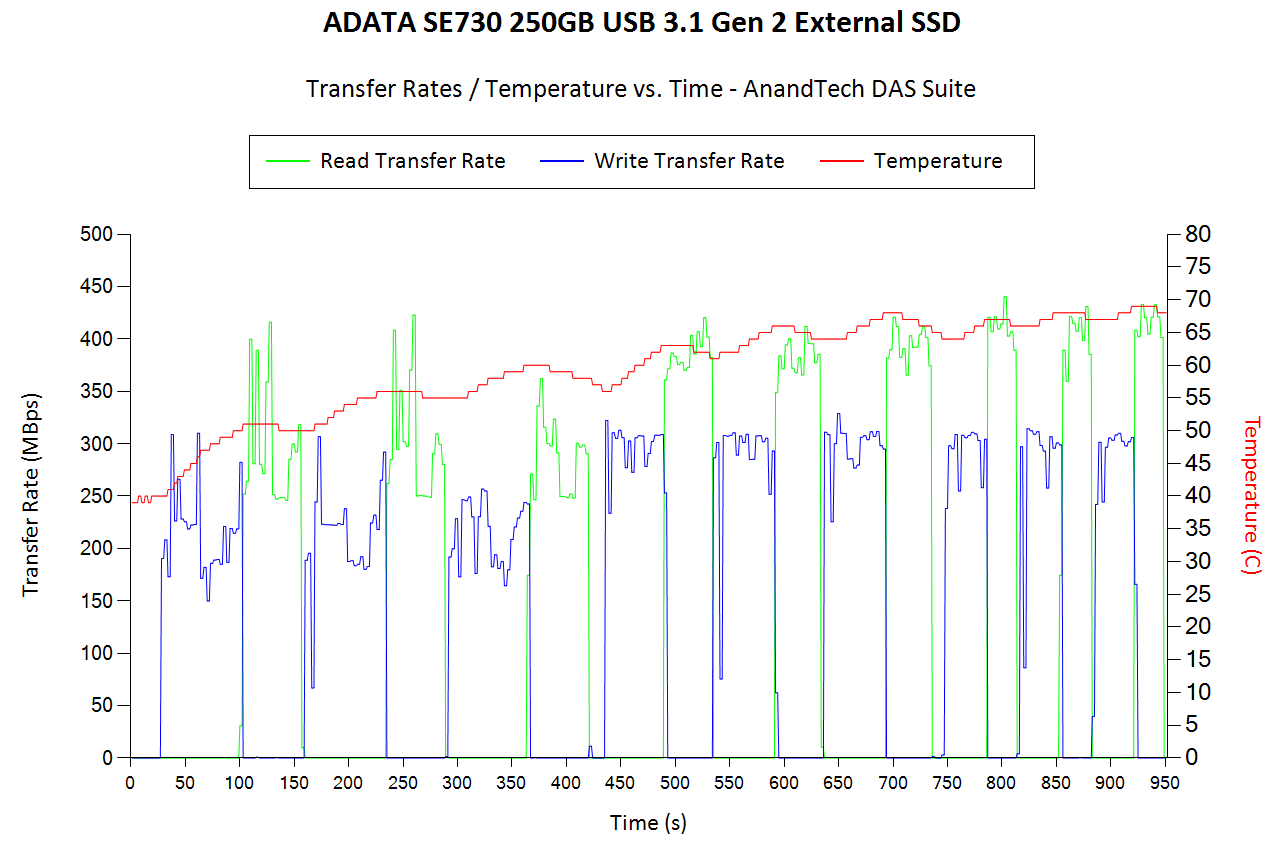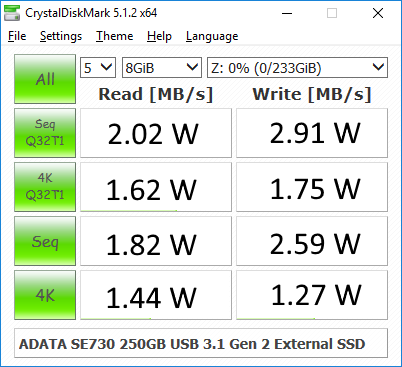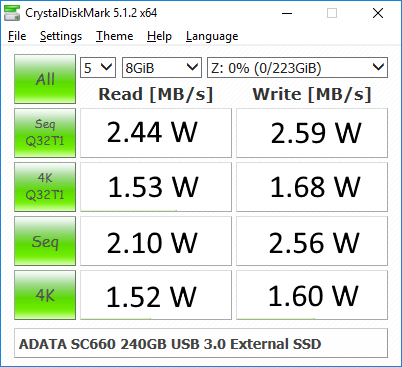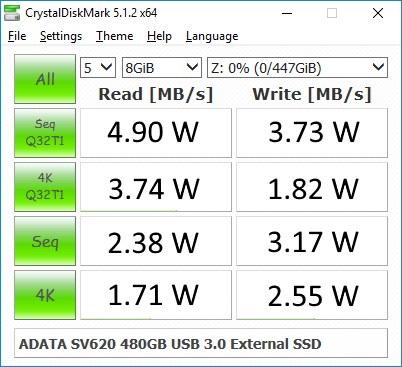ADATA SE730, SV620 and SC660 External SSDs Review
by Ganesh T S on November 4, 2016 2:15 PM ESTConsistency, Thermal Characteristics and Power Consumption
One of the most interesting aspects of external SSDs is the performance consistency for DAS workloads. Aspects that may influence this include thermal throttling and firmware caps on access rates to avoid overheating or other similar scenarios. Evaluating this is an important part of our benchmark process, as the last thing that users want to see when copying over, say, 100 GB of data to the external SSD, is the transfer rate going to USB 2.0 speeds. In order to identify whether the drive under test suffers from this problem, we instrumented our robocopy DAS benchmark suite to record the read and write transfer rates while the robocopy process took place in the background. For supported drives, we also recorded the internal temperature of the drive during the process. The graphs below show the speeds observed during our real-world DAS suite processing. The first three sets of writes and reads correspond to the photos suite. A small gap (for the transfer of the videos suite from the primary drive to the RAM drive) is followed by three sets for the next data set. Another small RAM-drive transfer gap is followed by three sets for the Blu-ray folder.
An important point to note here is that each of the first three blue and green areas correspond to 15.6 GB of writes and reads respectively. Throttling, if any, is apparent within the processing of the photos suite itself.

The SE730 has no performance consistency issues, though the temperature of the SSD goes as high as 70C. Our evaluation scheme is very taxing and goes beyond traditional usage scenarios (it is unlikely that any user would do 128GB writes and 128GB reads within a 20 minute interval on a 250GB external SSD). Despite the heavy load, the SE730 maintains its performance numbers. Unfortunately, the same can't be said for the SV620 and the SC660. The temperatures remain around 60 C for both, but the writes run out of steam after the SLC cache (around 6 - 8GB) is exhausted. The sustained write speeds for the SC660 240GB version seems to be around 75 MBps, while the SV620 480GB version is worse off at around 55 MBps. The reads do not have any issues, though. The sustained write problem is unfortunately an issue wth all TLC drives that employ a fixed-size SLC cache.
The power consumed by the SE730, SC660 and SV620 SSDs was measured under multiple scenarios using Plugable's USBC-TKEY power delivery sniffer. These scenarios were triggered using CrystalDiskMark 5.1.2 x64 with a 8GB test file and each test separated by a 30s interval.The average power consumption for each access trace was recorded. The pictures below present the numbers in a compact and easy to compare manner.
The numbers for the SC660 and SV620 are interesting in the sense that the drives continue to have spikes in the power consumption for a good 15 - 20s after the completion of the write access traces. This points to some SLC-TLC transfers taking place in the background. On the SE730 front, we are quite pleased to find that it is a very power-efficient platform.













9 Comments
View All Comments
stephenbrooks - Friday, November 4, 2016 - link
The construction of the SE730 is quite interesting because if the user didn't want it external any more they could plug the M.2 2242 module into their motherboard? I wonder if you could put a different M.2 drive in the casing?zodiacfml - Sunday, November 6, 2016 - link
Thinking the same thing....but I don't see myself purchasing such as these drives are more expensive and large compared to thumb drives to be used as portable storage. Working pros will benefit from the performance of these external drives.Wardrop - Monday, November 7, 2016 - link
Performance is definitely the main reason you'd be a drive like this. Been considering buying an external SSD for my Mac to bring it a little closer to performance to the internal SSD.Michael Bay - Saturday, November 5, 2016 - link
What about data retention? Such drives can spend a lot of time unplugged, I think, so it becomes actuall important.BrokenCrayons - Tuesday, November 8, 2016 - link
That's a good question. It's probably more of a concern for TLC models, but I can't imagine there's a way for Ganesh to test long term data retention and still write a review in a timely manner.pberger - Monday, November 7, 2016 - link
I just bought a new 4TB 2.5" external HDD (Seagate backup plus) for just under $100.Those SSD drives are about 10x more expensive, I pass!
Ithaqua - Monday, November 7, 2016 - link
Give it time.I'm replacing 2@2TB & 1@4TB with 2@8TB external HDD drives (I'd go 10 or 12TB if I could find them cheap).
But when I got the 1st 2TB the cost would be 50-100X for SDD. Now it's 10-20X for SDD. When it gets down to 4x (for me at least) that extra speed with USB 3.1 or 4.0 (or whatever it will be) will be a deciding factor.
BrokenCrayons - Tuesday, November 8, 2016 - link
Yup, for mass storage, it'll be a while before SSDs catch up in cost effectiveness, but I do think that since hard drive sales are slowing down, less R&D budget will be dedicated to capacity increases and mass production benefits will be more difficult to realize due to declining demand. It certainly looks like solid state storage is poised to catch up sooner or later.Like Mikey Bay mentioned in an above post, there's still some data retention problems with current NAND technologies and there's the write endurance problem too in some halo use case situations. For the next few years, I can't see mechanical hard drives going away since they have some small advantages in that respect as long as speed isn't a concern.
I've got to mention that I like solid state external storage though. I had a 120GB BP4 mSATA drive that came out of a laptop that failed. I popped the drive into a tiny USB 3.0 enclosure and it's nice to have something a little quicker than a standard thumb drive that's also pretty much drop-proof to shuffle files around. It's currently serving as a backup disk for documents, photos, and that sort of junk and it does the job nicely.
Ethos Evoss - Sunday, November 13, 2016 - link
Another pointless external ssd enclosure which will NEVER support TRIM as it is via USB interface..Such marketing..